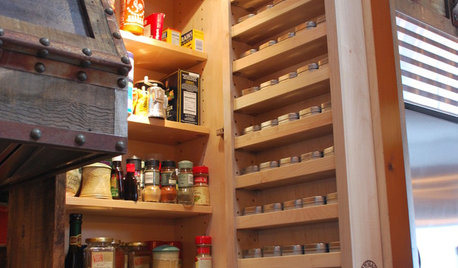(OT) Stuffing the genie back in the bottle
Melissa Northern Italy zone 8
5 years ago
Featured Answer
Sort by:Oldest
Comments (10)
Lisa Adams
5 years agoingrid_vc so. CA zone 9
5 years agoRelated Discussions
slightly OT... difficulty w/ indoor plants & flowers ; )
Comments (19)kathleen, yep--primarily birds... all species except eagles & vultures, though one can't help but learn a few things about other wildlife along the way when in the rehab field as deeply and as insanely as I was. I think that I shall have to write something of my former life in "My Page" because people are probably sick of me repeating myself... I know *I* am...lol I began caring for wild birds in 1983, established a non-profit org. in 1989, the org. folded in 2002 when I couldn't keep up with it all as my health continued to decline. I am--for most practical purposes--retired but still have an aviary with [mostly] wild birds (and state & federal permits). On a very good day, I may take in a bird needing rehab if the situation is such that the bird won't need intensive care--or at least not for more than a few hours--or, of course, if it is a *corvid* (crow, magpie, jay, raven)! Oh those wimpy exclusively raptor people have it easy as the young only need fed 3-5 times daily compared to the majority of birds brought in for rehab that never shut their mouths and must be fed every 15 to 60 minutes... depending on condition, age & species of the baby. I can say this because "Sam" & Bob of Wild At Heart are friends. Actually, I first met Sam when she was at a training class for songbirds that I and another rehabilitator were teaching on behalf of Liberty Wildlife in 1987; I've known Jeani since she began as well. Btw, Wild At Heart *is* the best place in the Phx metropolitan area for hawks & owls to receive good care... and I'm not just saying that because I personally like 'em ( :> Ya' know, there are a lot of things that we've fed birds that you don't even want to know about --not to mention what's in our freezers... LOL (Well, my freezer collection ain't what it used to be!) *Thanks* for your --->kind...See MoreOT- weather again- Fall's here!
Comments (19)It got to 92F yesterday and weatherguy claims it's gonna be 91F on both Friday and Sunday, but the lows are supposed to be in the mid-50s. It takes until very-late afternoon to heat up and then it cools right back off just as you're considering whether or not to switch on the AC. Late last night we had a brief but heavy rain - just enough to encourage that damned grass to keep on growing (I've been mowing since March and am sick of it). On the upside, the 2nd-season zucchini appears to be completely free of bugs and is cranking out beautiful, picture-perfect squashes. And the majority of large tomatoes has finally - finally! - decided to ripen up. Also, a little experiment has worked out a lot better than I ever would've thought. I was at Wal*Mart the last week of May and the garden lady was tidying stuff up. She had a bag of seed potatoes that looked way past their prime and was about to toss them into the trash, so I asked if I could have them at a reduced price. She said I could just have them, since she didn't think they were any good (in truth, they looked pretty sad). When I got home I threw the bag in a bucket and forgot about'em until two weeks later, by which time they were beyond sad and just pitiful. But, I had an unused, double-dug bed on the east side of the house just sitting there with nothing planned for it until fall (2nd garlic bed), so I planted those poor, dehydrated taters. That night the skunk that hangs out here had a merry old time in the nice, soft bed rooting about for grubs and such and of course the potatoes were scattered all over and had to be replanted. Amazingly, they grew and today I dug out a single hill - 4 pounds of potatoes! And most are the size of store-bought bakers. I nearly fell over, I was so surprised. Anyhoo, kinda got off track there but thought this might be useful for someone else....See MoreOT Dorothy...Brain teaser 2
Comments (17)LOL Both of you. I'm still trying to figure out "ALL THE CLUES" LOL I have no idea the what any of the answers to any of the clues are, Oh one was "Heart." Still trying. Dorothy...See Morehere's the genie bottle I recently did...
Comments (10)thankyou...it's both a gift and a curse, cuz I don't see things for just what they are..there are always 'alternatives' to nearly everything. a trip to a thrift store is very, very difficult.. I can be looking for a simple thing, like a bowl.. it never looks like a bowl..it's a mushroom cap, to sit on the fireplace hearth, or a mosaiced ice cube server, a base for clay, to sit sideways, for a round scene, with a base, for it to sit on and look into a 'window winter, or spring, or summer or even autumn scene'... a potential concave 'wreath', with manmade 'snow', with reindeer, bells around the round edge, with cedar branches and twigs.... it's supposed to be a dammed simple bowl on the shelf, for cryin' out loud..but as soon as I see it...it morphs! it's not just a bowl..it happens to so many things..it really does make my mind crazy, some times. it's both annoying and entertaining but the ideas don't just stop, as soon as I leave the store.. it's like a train wreck at times. I actually have to take a note book with me, so I can get ideas down and can just leave it alone.. I think I mentioned that once, having to do with not being able to sleep at night. ideas start to crop up...dreams are a bother..it gets complicated. hence, the Rx's...lol (laugh, but true). the bottle is only a hint. I don't/can't do intricate..well, yes I can but won't/can't take the time to do intricate,cuz I am a perfectionist, with a lazy flair. geez, I'm hoping I'm not giving a negative impression, for mentioning this...lol some friends and family have made mention of the word "loopy" around me..lovingly, I think.. here's a few more pictures of the fun I had with the bottle.. this one is sitting in a tray, with some of the actual sea glass, shells, metal finds and junk from the shore, along Hoodsport, on inner Puget Sound. and this brings you right up to the ones submitted for the challenge... and yes, you're right..the first exchange was the frying pans, where mine went to NT... I got in trouble, while cleaning the grout off of that pan..I had it with me, when I went to court with a friend, on a district citation.. I was sitting in the front row, waiting for him and had a chop stick, using it to get into tiny areas, to get the grout out... during court, the judge stopped and said "mam, you need to either leave the courtroom or put what you have away..it could be considered a 'contraband weapon' in here.. whf??? so, I just stuffed it in my baggy bag, for crafts and sat out the rest of court. the moss on the edge of that pan was from the Skokomish Indian Reservation..I was up in the hills, where it's all natural Indian land and natives gather reeds and grasses for their basket weaving. it's a culturally rich area. that's over where the 'crazy beach' is, that my grandson calls it. I love and appreciate art work that people do, with precision and intricacy... my feelings and emotions don't fit into that arena.I feel more loose and out of bounds. possibly because I have so many things that I worry about...I dunno.. but I sure would love to 'get out of Dodge' for awhile... I need to 'decompress'. be a bona-fide beach bum for a few days!...lol .(*_*)....See MorePlumeria Girl (Florida ,9b)
5 years agoPlumeria Girl (Florida ,9b)
5 years agoUser
5 years agoMelissa Northern Italy zone 8
5 years agolast modified: 5 years agoUser
5 years agoRosefolly
5 years agoMelissa Northern Italy zone 8
5 years ago
Related Stories

HOUSEKEEPINGCan-Do Cleaning Strategies for Busy People
While you dream of having a maid (to go with the cook and chauffer), this simplified cleaning routine can keep your real-world home tidy
Full Story
DECLUTTERING10 Decluttering Projects You Can Do in 15 Minutes or Less
Try these ideas to get organized at home one small step at a time
Full Story
KITCHEN DESIGN7 Steps to Pantry Perfection
Learn from one homeowner’s plan to reorganize her pantry for real life
Full Story
MOST POPULAR5 Ways to Pare Down Your Stuff — Before It Gets in the Door
Want to free up some room around the house? Rethink gift giving, give yourself a shopping mantra and just say, ‘No, thank you’ to freebies
Full Story
THE HARDWORKING HOMEClever Ways to Rethink the Linen Closet
The Hardworking Home: Get rid of those toppling piles with these ideas for organizing bedding, towels and more
Full Story
DECORATING GUIDESFrom Queasy Colors to Killer Tables: Your Worst Decorating Mistakes
Houzzers spill the beans about buying blunders, painting problems and DIY disasters
Full Story
MOST POPULARThe 15 Most Popular Kitchen Storage Ideas on Houzz
Solve common kitchen dilemmas in style with custom and ready-made organizers, drawers, shelves and more
Full Story
MOVINGTop 5 Areas to Declutter Before You Move
Make packing for a relocation less painful by tackling these places first
Full Story






Melissa Northern Italy zone 8Original Author